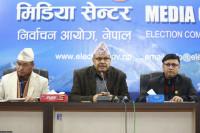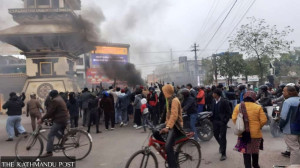National
How do transwomen describe themselves? Women.
The multi-coloured skirt is hard to miss as Rukshana Kapali makes her way through the afternoon crowd at Patan Durbar Square. It is not just a mere fashion choice but a statement to her identity. While some are oblivious to her presence, others need to take a second glance, but for Kapali, this has been a norm since she came out as a transwoman around five years ago.
Asmita Manandhar
The multi-coloured skirt is hard to miss as Rukshana Kapali makes her way through the afternoon crowd at Patan Durbar Square. It is not just a mere fashion choice but a statement to her identity. While some are oblivious to her presence, others need to take a second glance, but for Kapali, this has been a norm since she came out as a transwoman around five years ago.
“The social narrative is mostly black and white when it comes to recognising gender identity in Nepal,” Kapali says regarding the categorisation of transwomen like her under ‘third gender’. Assigned male at birth, Kapali now identifies as a woman but according to her, she is rarely grouped within the spectrum of womanhood as her cis-women counterparts.
On December 21, 2007, the Supreme Court of Nepal recognised the transgender individuals as a third gender under the public interest litigation filed by Sunil Babu Pant, the first openly gay legislator in Nepal, against the government of Nepal. The court issued a directive order to the defendants to create new—and amend the already existing—laws to eliminate any discrimination based on sexual orientation and gender identity of an individual. The decision, till this day, is considered a landmark victory for the LGBTIQ movement in Nepal.
Bhumika Shrestha, who was crowned the winner of Miss Pink beauty pageant for transwomen in the same year even acquired her passport with her gender acknowledged as ‘O’ for others or third gender—neither male or female.
With the LGBTIQ movement growing at a steady pace, Shrestha was the face of transgender women in the mainstream popular culture for a long time.
“The social notion and media’s portrayal of the transgender people have come a long way since 2007. There have been academic discourses in favour of us gender minority as well and all this has certainly increased our visibility in the society,” she says.
Shrestha has also acted in two Nepali films—Highway and Kanchhi—where she portrayed the role of a transwoman. “Earlier, people of gender minority were incorporated in the films only for comic relief but my roles in both the films were sensitive towards our issue,” she says.
However, for her role in Kanchhi, a more feminine voice was dubbed over Shrestha’s original voice during the movie’s post-production. According to Pinkey Gurung, chairperson of Blue Diamond Society, that small edit indicates the popular media’s reluctance to break out of the social narrative.
“It plays on the social stereotype that there should be a certain level of feminine qualities to be considered as a woman and it puts a lot of pressure on transwomen,” Gurung says.
The pressure to ‘look’ woman for transwomen is what Kapali has also witnessed among her peers. “A cis-woman definitely does not put so much effort, from make-up to dressing up as much as transwomen have to do to fit in the social mould,” she says.
But amid all the social expectations and stereotypes, unlike Kapali, Gurung does not mind identifying herself as third gender.
“There is a lot of debate on how individuals would like to identify,” she says. “Some members of the hijra community in India would prefer to be identified as hijra rather than transgender. Similarly, being identified as a third gender in Nepal is important because it brings visibility to the whole community.”
Kapali, on the other hand, says that the queer community needs to focus on narrative shaping away from the traditional binary roles and stereotypes in order to make the community more inclusive.
“How do non-binary, gender fluid and intersex people feel welcome in our community if we, as queers, emphasise the gender binary and label ourselves as an extension of that binary capacity? Why are we pigeonholing ourselves?” she says.
In order to include all gender minorities, Rukshana says that she is also moving away from the term LGBTIQ and starting to adopt another acronym: MOGAI (pronounced MUGGY) as an umbrella term. MOGAI stands for marginalised orientation (sexual/romantic), gender alignment (identity/expressions) and intersex bodily variation.
Although Gurung agrees that there is a lot of confusion among the queer community regarding their own identity and sexuality, the movement also has to take into account the socio-political environment of the country. “We take one step at a time,” she says.
Sunil Babu Pant, through his piece published in the Medium in 2017, expressed his position on driving the LGBTIQ movement through the philosophical alignment with the Nepali tradition and social norms, defending the celebration of Gai Jatra by the queer community rather than organising a separate event in Western countries like the Pride March.
Gurung, who represents the organisation that has been advocating the rights of the queer community since 2001, concurs with the idea that social acceptance and understanding is imperative for the movement to move forward. Following conventions at times, Gurung says, can have its merits.“Many transwomen working as make-up artists are well versed in the craft because they practise it on themselves every day to build feminine features,” she says. “This has created a lot of career opportunities for them.”
But for most of them, it is not always as simple to form a career base as a transwoman.
Although Anjali Lama has become the face of success amongst the queer community after she walked the ramp for the Lakme Fashion Week in India, Meghna Lama says she faced a lot of discrimination when auditioning for a major fashion event in Nepal.
“Although we were given various excuses for why we weren’t selected to walk the ramp, we knew we were disqualified for being transwomen. Both Anjali and I were never selected for two to three consecutive years after which I just gave up. Anjali went on to audition in India and proved that she had it in her anyway,” she says.
Still, Meghna Lama, who now runs Pink Tiffany, Kathmandu’s first openly LGBTIQ-friendly restaurant, says transwomen have not been fully included in the spectrum of womanhood in Nepal. “It is ridiculous how much we have to assert ourselves as a woman,” she says.
At the moment, Lama holds a passport that identifies her as a male but she says that she would rather have her passport identified as a female than ‘other’. “It just invites a lot of discrimination and travel restrictions if I have a passport that gives away my gender identity. I can be criminalised in some countries just because of my identity,” she says.
Although the 2007 Supreme Court verdict and the Constitution of Nepal acknowledge “right to have one’s own identity”, even quoting international covenants such as International Covenant for Civil and Political Rights and International Covenant for Economic, Social and Cultural Rights, the new bill registered by the Home Ministry in Parliament demands a proof of gender transformation to obtain a new citizenship. This has been regarded as discriminatory by the queer community and rights activists and undermines the basic principle of the human right of self-determination.
“The bill is vague and open to interpretation,” says Kapali. “My gender identity should be at my discretion and I shouldn’t be forced to provide any proof—especially in this case that indicates a sex change operation. This is also one of the reasons why we need to broaden the discourse of queer identity.”
Gurung, the Blue Diamond Society chair, says that there is no legal provision for sex change in Nepal and the procedure is so expensive that not all transgender people can afford it. “Some people just don’t want to go under the knife while others may have to refrain from the procedure due to their health complications. This does not make them any less of what they believe they are,” she says.
Transgender activists say these discriminatory policies only add to the regressive narratives that require transwomen to experience further adversity and humiliation just to assert their identity. By putting the burden of proof on the individuals without the state taking any initiative to facilitate the establishment of safe space for the gender minorities, activists say the government is only fuelling misinformation and discrimination from policy level to social environment.
“Many women’s rights organisations have this incorrect notion that transwomen are not part of the women movement,” Kapali says. “But just like the intersectional issues regarding Dalit women, indigenous women under the women’s movement, ours also mandates a space because transwomen are women."




 5.6°C Kathmandu
5.6°C Kathmandu.jpg)






%20(1).jpg&w=300&height=200)








